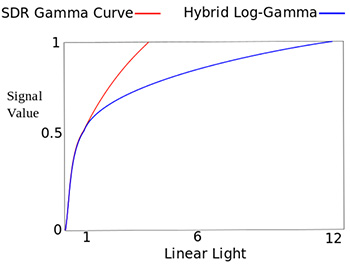Tip #745: What is HDR Rec. 2020 HLG
… for Codecs & Media
Tip #745: What is HDR Rec. 2020 HLG
Larry Jordan – LarryJordan.com
HLG is compatible with both HDR and SDR broadcast and television sets.


High-dynamic-range video (HDR video) describes video having a dynamic range greater than that of standard-dynamic-range video (SDR video). HDR capture and displays are capable of brighter whites and deeper blacks. To accommodate this, HDR encoding standards allow for a higher maximum luminance and use at least a 10-bit dynamic range in order to maintain precision across this extended range.
While technically “HDR” refers strictly to the ratio between the maximum and minimum luminance, the term “HDR video” is commonly understood to imply wide color gamut as well.
There are two ways we can display HDR material: HLG and PQ. (Tip #746 discusses PQ).
HLG (Hybrid Log Gamma) is a royalty-free HDR standard jointly developed by the BBC and NHK. HLG is designed to be better-suited for television broadcasting, where the metadata required for other HDR formats is not backward compatible with non-HDR displays, consumes additional bandwidth, and may also become out-of-sync or damaged in transmission.
HLG defines a non-linear optical-electro transfer function, in which the lower half of the signal values use a gamma curve and the upper half of the signal values use a logarithmic curve. In practice, the signal is interpreted as normal by standard-dynamic-range displays (albeit capable of displaying more detail in highlights), but HLG-compatible displays can correctly interpret the logarithmic portion of the signal curve to provide a wider dynamic range.
HLG is defined in ATSC 3.0, among others, and is supported by video services such as the BBC iPlayer, DirecTV, Freeview Play, and YouTube. HLG is supported by HDMI 2.0b, HEVC, VP9, and H.264/MPEG-4 AVC.


Leave a Reply
Want to join the discussion?Feel free to contribute!